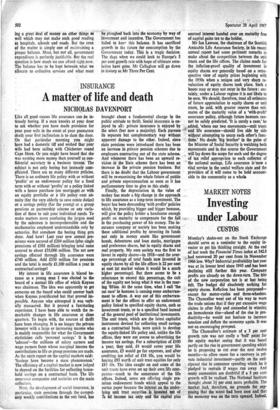Investing under Labour
MARKET NOTES CUSTOS
Monday's shake-out on the Stock Exchange should serve as a reminder to the equity in- vestor to get his thinking straight. At the end of last week the Financial Times index at 342.8 had recovered 20 per cent from its November 1966 low. Why? Industrial profitability last year was at its lowest level since 1945 and has been declining still further this year. Company profits are already on the down-turn. The bite of the new corporation tax is at last being felt. The budget did absolutely nothing for equity shares. Reflation has been postponed— except for motor-cycles and three-wheelers. The Chancellor went out of his way to warn the trade unions that if they put excessive wage claims in after July and succeeded in winning an immoderate rise—ahead of the rise in pro- ductivity—he would not hesitate to increase taxation and deflate the economy again. It was not an encouraging prospect.
The Chancellor's estimate of a 3 per cent growth rate was not really a 'bull' point for the equity market seeing that it was based partly on the rise in government spending which he is proposing to cut over the next twelve months—to allow room for a recovery in pri- vate industrial investment—partly on the anti- cipated rise in consumer spending which he is pledged to restrain if wages run away. And many economists are doubtful if a 3 per cent growth will be realised. The National Institute thought about if per cent more probable. The market had, therefore, no grounds for sup- posing that the worst had been seen and that the economy was on the turn upward. Indeed,
if the new prices and incomes legislation, lack- ing all compulsory powers, tends to work _against prices rather than against wages, profit margins will be squeezed dangerously tight and dividends widely cut. So the ending of the divi- dend freeze really meant nothing. The equity market, from an economic point of view, had simply risen too fast.
From a technical point of view, the recovery in the market was more understandable. After a severe fall—the Financial Times index dropped 23 per cent between June and Novem- ber 1%6—there is usually what is known as a primary recovery. The coming nationalisation of steel ordinary shares meant that many mil- lions of equity money had to come back into the equity market and no doubt some specula- tive investors decided to anticipate it. Further, some institutional investors, seeing that the per- centage of their funds invested in equities had fallen through depreciation to below its normal level, came on the equity feed again and were encouraged by a number of takeover bids. Finally, the decline in the issues of new equity shares, which the new corporate taxation brought about, reduced the market supply of shares to a point below current demand from unit trusts, pension funds and private specu- lators. Technical market conditions often have an irrational appearance.
Nevertheless, one usually expects the pro- fessional managers of portfolios to behave more rationally than the market herd. Yet many new trusts were formed early in 1966 with so-called capital and income shares to attract the different types of new investors. Take Triple- vest, for example, formed at the end of January 1966. By February 1967 86 per cent of its total issue of £20 million net had been invested in equities and had suffered a depre- ciation of 10+ per cent (against an index fall of 15 per cent). Thus £1,800,000 depreciation has been suffered by the (£6 million) capital shareholders. The professional investors do not seem to have adjusted themselves to the economic management under Labour.
It has, of course, been a difficult time and few would have guessed that the man who backed the gilt-edged market last autumn would have come home with all the profits to be had out of the Stock Exchange.







































 Previous page
Previous page